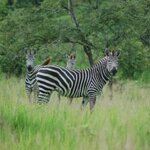Evolution

We are all familiar with the Mafia. In China, it is the Triads, in Italy it is La Cosa Nostra. You pay for protection or disaster is sure to befall you.
It happens in the bird world too, according to a new report. A bird will lay an egg in your home and you will raise the hatchling or pay the price. Throw the little parasite out and an accident will befall your nest.
It is a child-rearing strategy, but is it an effective one? Evolutionary biologist Amotz Zahavi postulated the mafia hypothesis back in 1979 and it has been contentious ever since. Critics argue that the retaliation gives the…

Without knowing it, organisms search for the next “winning” strategy in evolution. Mutation plays a key role in the evolution of new, and sometimes successful, traits. It's a lot like rock-paper-scissors - roshambo.(1)
An example often cited by biologists is male side-splotched lizards of the southwestern United States. The lizards exhibit varying levels of aggression as a way of out-competing one another for territory and mating rights.(2) Males with blue throats display moderate aggression, allowing them to patrol a relatively small territory and mate with relatively few females.…

A new paper suggests that genes evolve more rapidly in species containing germ plasm, which
challenges a long held belief about the way certain species of vertebrates evolved.
The results came about as the researchers put to the test a novel theory that early developmental events dramatically alter the vertebrate body plan and the way evolution proceeds.
Dr. Andrew Johnson from The University of Nottingham proposed the idea just over 10 years ago. His view is that the relationship between the germ line (hereditary germ cells that create sperm and eggs) and the soma (…

Fruit flies are secretly harboring the biochemistry needed to glow in the dark —otherwise known as bioluminescence - according to a paper in
Proceedings of the National Academy of Sciences.
The key to activating this latent ability is a novel synthetic analog of D-luciferin developed at University of Massachusetts Medical School, say the authors, who suggest that the inherent biochemistry needed for bioluminescence is more common than previously thought.
Synthetic luciferins can unmask latent enzymatic activity capable of producing light in animals not known for their…

Harvard evolutionary biologist Professor David Haig believes that infants that wake frequently at night to breastfeed are delaying the resumption of the mother's ovulation and therefore preventing the birth of a sibling with whom they would have to compete.
Yes, babies are genetically determined to crawl do anything it takes to not just survive, but outlast. So much for the "milk of human kindness".
Population studies have associated smaller gaps between the births of siblings and increased mortality of infants and toddlers, albeit weakly, but once they lump in environments where resources…

In a new paper, researchers writing in Current Biology show how lactase persistence variants tell the story about the ancestry of the Khoe people in southern Africa and that their pastoralist practices were probably brought to southern Africa by a small group of migrants from eastern Africa.
Lactase persistence is the ability to digest milk into adulthood. There are a number of different genetic variants associated with lactase persistence and they are heterogeneously distributed in global populations. These variants were likely targets of selection when some populations converted from hunter…

Although Neanderthals are extinct but fragments of their genomes persist in modern humans.
These shared regions are unevenly distributed across the genome and some regions are particularly enriched with Neanderthal variants. An international team of researchers led by Philipp Khaitovich of the Max Planck Institute for Evolutionary Anthropology in Leipzig, Germany, and the CAS-MPG Partner Institute for Computational Biology in Shanghai, China, have found that DNA sequences shared between modern humans and Neanderthals are specifically enriched in genes involved in the metabolic breakdown…

Why zebras have black and white stripes is a long-standind puzzle of evolution.
To find out, the researchers behind a Nature Communications paper mapped the geographic distributions of the seven different species of zebras, horses and asses, and of their subspecies, noting the thickness, locations, and intensity of their stripes on several parts of their bodies. Their next step was to compare these animals' geographic ranges with different variables, including woodland areas, ranges of large predators, temperature, and the geographic distribution of glossinid (tsetse flies) and tabanid (…

Genghis Khan is famous in evolution because a giant chunk of the world carries is DNA. A recent story of brown bears shows that males roam much greater distances than females, and mating is part of the agenda.
For bear evolution, studying the paternally inherited Y chromosome is good way to trace both the geographic dispersal and genetic differences between bear species because it adds to current knowledge about range-wide population structuring in mammals from maternally inherited mitochondrial DNA (mtDNA). If males travel more than females, the pronounced population structuring…

If you become saucer-eyed when afraid or you squint from disgust, it may not be cultural - it may be biology. Near-opposite facial expressions like squinting and being wide-eyes are rooted in emotional responses that exploit how our eyes gather and focus light to detect an unknown threat, according to a study by Adam Anderson, professor of human development in Cornell's College of Human Ecology, and colleagues.
Our eyes widen in fear, boosting sensitivity and expanding our field of vision to locate surrounding danger. When repulsed, our eyes narrow, blocking light to sharpen focus and…